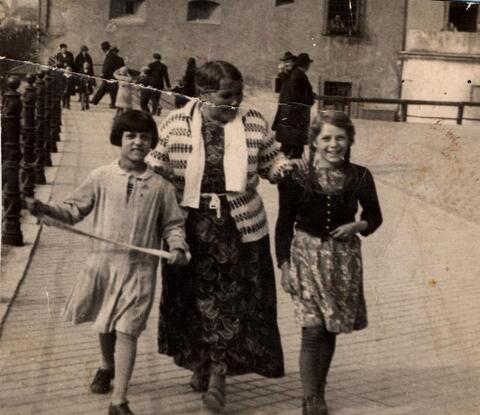Targeting the Sinti and Roma
At a Glance
Language
English — USSubject
- History
- The Holocaust
We Call Ourselves "Roma"
The fate of the Sinti and Roma was similar to that faced by Jews in Germany during World War II. Like the Jews, the Sinti and Roma had lived in Germany and other European countries for a very long time. The Sinti are believed to have settled in Germany about 600 years ago. The Roma, a term often used to describe all “Gypsies,” came to Germany from Hungary and other parts of eastern Europe between 80 and 150 years earlier than the Sinti.
Sinti Woman in Germany

Sinti Woman in Germany
An elderly Sinti woman walks down a German street with her grandchildren in the 1930s.
Tackling Discrimination against Roma in Schools
For centuries, Europeans had feared and mistrusted the Sinti and, later, the Roma. For a variety of reasons, probably including the fact that they were not fully accepted into European societies, many Sinti and Roma did not settle in specific communities but instead remained nomadic. This helped to strengthen their image as outsiders. They were often accused of every conceivable crime and stereotyped as “anti-social” and “work-shy.” During World War I, they were regarded in Germany as potential spies and required to register with the police so that their movements could be monitored. When the Nazis came to power in 1933, they paid little attention to the Sinti and Roma until local and state authorities began applying the nation’s new “racial laws” to the 26,000 “Gypsies” in Germany. Local governments used the new laws to take action on long-held enmities and stereotypes.
In 1933, some Sinti and Roma were forcibly sterilized under the Law for the Prevention of Hereditarily Diseased Offspring, and in 1935 they were included in the Law for the Protection of German Blood and Honor (see reading, Breeding the New German "Race" in Chapter 5). By 1936, some Sinti and Roma were being sent to concentration camps. In 1938, Heinrich Himmler, the chief of the German police and head of the SS, issued a decree called “The Fight against the Gypsy Menace.” It required that all Sinti and Roma register with the police; it also kept foreign Sinti and Roma from entering the country.
The next step was mass deportation to various concentration camps. One Sinti, then a boy known as Bubili, recalled his arrival at one of those camps:
[On June 28, 1939,] the train stopped just outside the gates of Dachau. We waited, locked in the airless boxcar for about three quarters of an hour. Then we heard a shout as thirty or forty young SS men unlocked the bolts and threw open the doors. “Austrian pigheads,” they screamed. “Out, out. Run, you Congo n---s, run.” Their whips fell on us, killing two men as we ran toward the gates of Dachau.
. . . The whole square was filled prisoners in striped uniforms. Many of them wore yellow stars on their shirts [indicating that they were Jews]. The others had different colored triangles on their uniforms [indicating that they were Sinti, Roma, homosexuals, Jehovah’s Witnesses, or political prisoners].
We stood on the assembly place, the sun beating down on us from early morning until three in the afternoon. If someone dropped, we were not allowed to pick him up. Then an SS man with a whip drove us into a building.
“Sit down,” the guard said. He held a board with my name and number 34016 across my chest. The photographer snapped my picture. With his foot, the photographer pushed a lever that punched a nail into my rear. Like a trained monkey, I jumped through the small window leading to the property room. Why couldn’t they just tell us to get up instead of punching us with a nail?
In the property room, the guards shouted at us, “Take off all your clothes. Put everything else in the two baskets—your jewelry, your papers, your money.” We stood there naked as the guards led us toward the showers. It was after the shower I lost my hair. I wondered what more could the Nazis do to us?
The prisoners in charge of the clothing laughed as they threw it at us. If you were tall, you got striped pants that were too short. If you were short, you got striped pants that were too long. I could not look any more ridiculous. I “found” thread and shortened my pants.
The shoes were even worse. Only the kapos, the prisoners in charge of other prisoners, and the block “elders” had leather shoes. . . . It was summer, and we were taken out to help the farmers bring in crops. At the risk of my life, I smuggled potatoes in my shirt into camp. The big commodity was schnapps (whiskey). By bartering, I got schnapps which someone had stolen from the SS. The schnapps I traded for leather shoes. 1
In 1939, “Gypsies,” Jews, and other prisoners thought that the concentration camps were the last step in the process of isolation and dehumanization. Few imagined that the worst was yet to come.
Connection Questions
- How and why did the Nazis target Sinti and Roma people?
- What effects did the laws described in this reading have on Sinti and Roma? What effects might they have had on other Germans?
- What is the meaning and purpose of “dehumanizing” a group of people? What are examples in this reading of such dehumanization?
- 1From “Bubili: A Young Gypsy's Fight for Survival,” in Ina R. Friedman, The Other Victims: First-Person Stories of Non-Jews Persecuted by the Nazis (Boston: Houghton Mifflin, 1990), 18–19.
How to Cite This Reading
Facing History & Ourselves, "Targeting the Sinti and Roma," last updated August 2, 2016.








